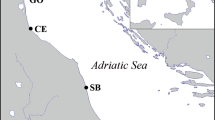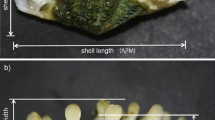Abstract
The skeletal Mg/Ca ratio of echinoderms is known to increase with temperature but the relation has never been established in controlled experimental conditions. The present study investigated the effect of temperature, salinity and growth rate on Mg/Ca and Sr/Ca ratios in calcite skeletons of juvenile sea urchins grown in experimental conditions. Mg/Ca ratio was positively related to temperature, increasing until a plateau at high but field occurring temperatures. It was not linked to salinity nor growth rate. We suggest that this plateau is due to properties of the organic matrix of mineralization and recommend to take it into account for the use of Mg/Ca as proxy of seawater Mg/Ca. Skeletal Sr/Ca ratio was mainly dependent on temperature and growth rate, as usually observed in calcite skeletons.



Similar content being viewed by others
References
Bentov S, Erez J (2006) Impact of biomineralization processes on the Mg content of foraminiferal shells: a biological perspective, Geochem Geophys Geosyst 7. doi:10.1029/2005GC001015
Berman A, Addadi L, Weiner S (1988) Interactions of sea-urchin skeleton macromolecules with growing calcite crystals: a study of intracrystalline proteins. Nature 331:546–549
Borremans C, Hermans J, Baillon S, André L, Ph Dubois (2009) Salinity effects on the Mg/Ca and Sr/Ca in starfish skeletons and the echinoderm relevance for paleoenvironmental reconstructions. Geology 37(4):351–354. doi:10.1130/G25411A
Carré M, Bentaleb I, Bruguier O, Ordinola E, Barret NT, Fontugne M (2006) Calcification rate influence on trace element concentrations in aragonitic bivalves shells: evidences and mechanisms. Geochim Cosmochim Acta 70:4906–4920. doi:10.1016/j.gca.2006.07.019
Chave KE (1954) Aspects of the biogeochemistry of magnesium 1. Calcareous marine organisms. J Geol 62:266–283
Cheng X, Varona PL, Olszta MJ, Gower LB (2007) Biomimetic synthesis of calcite films by a polymer-induced liquid-precursor (PILP) process—1. Influence and incorporation of magnesium. J Cryst Growth 307:395–404. doi:10.1016/j.jcrysgro.2007.07.006
Clarke FW, Wheeler WC (1922) The inorganic constituents of marine invertebrates. Prof Pap US geol Surv 124:56
De Deckker P, Chivas AR, Shelley JMG (1999) Uptake of Mg and Sr in the euryhaline ostracod Cyprideis determined from in vitro experiments. Palaeogeogr Palaeoclimatol Palaeoecol 148:105–116. doi:10.1016/S0031-0182(98)00178-3
Dickson JAD (2002) Fossil echinoderms as monitor of the Mg/Ca ratio of Phanerozoic oceans. Science 298:1222–1224. doi:10.1126/science.1075882
Dubois Ph, Chen CP (1989) Calcification in echinoderms. In: Jangoux M, Lawrence JM (eds) Echinoderm studies. AA Balkema, Rotterdam, 3, pp 109–178
Feely RA, Sabine CL, Lee K, Berelson W, Kleypas J, Fabry VJ, Milleros FJ (2004) Impact of anthropogenic CO2 on the CaCO3 system in the oceans. Science 305:362–366. doi:10.1126/science.1097329
Grosjean PH, Spirlet C, Jangoux M (1996) Experimental study of growth in the echinoid Paracentrotus lividus (Lamarck, 1816). J Exp Mar Biol Ecol 201:173–184. doi:10.1016/0022-0981(95)00200-6
Kısakürek B, Eisenhauer A, Böhm F, Garbe-Schönberg D, Erez J (2008) Controls on shell Mg/Ca and Sr/Ca in cultured planktonic foraminiferan, Globigerinoides ruber (white). Earth Planet Sci Lett 273(3–4):260–269. doi:10.1016/j.epsl.2008.06.026
Le Gall P, Bucaille D, Grassin JB (1990) Influence de la température sur la croissance de deux oursins comestibles Paracentrotus lividus et Psammechinus miliaris. In: De Ridder C, Dubois P, Lahaye MC, Jangoux M (eds) Echinoderm research. AA Balkema, Rotterdam, pp 183–188
Lea DW (2003) Elemental and isotopic proxies of past Ocean temperatures. In: Elderfield H (ed) The Oceans and Marine Geochemistry. Elsevier-Pergamon, Oxford, 6, pp 365–390. doi: 10.1016/B0-08-043751-6/06114-4
Lea DW, Mashiotta TA, Spero HJ (1999) Controls on magnesium and strontium uptake in planktonic foraminifera determined by live culturing. Geochim Cosmochim Acta 63:2369–2379. doi:10.1016/S0016-7037(99)00197-0
Lewis CA, Ebert TA, Boren ME (1990) Allocation of 45calcium to body components of starved and fed purple sea urchins (Strongylocentrotus purpuratus). Mar Biol 105:213–222. doi: 10.1007/BF01344289
Lorrain A, Gillikin DP, Paulet Y-M, Chauvaud L, Le Mercier A, Navez J, André L (2005) Strong kinetic effects on Sr/Ca ratios in the calcitic bivalve Pecten maximus. Geology 33(12):965–968. doi:10.1130/G22048.1
MEDAR Group (2002) MEDATLAS 2002 database. Mediterranean and Black Sea database of temperature, salinity and biochemical parameters. Climatological Atlas. Ifremer Editions
Morse JW, Mackenzie FT (1990) The oceanic carbonate system and calcium carbonate accumulation in deep sea sediments. In: Morse JW, Mackenzie FT (eds) Geochemistry of sedimentary carbonates: developments in sedimentology, vol 48. Elsevier, Amsterdam, pp 133–177
Nakano E, Okazaki K, Iwamatsu T (1963) Accumulation of radioactive carbon in the larvae of the sea urchin Pseudocentrotus depressus. Biol Bull 125:125–132
Nürnberg D, Bijma J, Hemleben C (1996) Assessing the reliability of magnesium in foraminiferal calcite as a proxy for water mass temperatures. Geochim Cosmochim Acta 60(5):803–814. doi:10.1016/0016-7037(95)00446-7
Pilkey OH, Hower J (1960) The effect of the environment on the concentration of skeletal magnesium and strontium in Dendraster. J Geol 68(2):203–214
Politi Y, Arad T, Klein E, Weiner S, Addadi L (2004) Sea urchin spine calcite forms via a transient amorphous calcium phase. Science 306(5699):1161–1164. doi:10.1126/science.1102289
Politi Y, Mahamid J, Goldberg H, Weiner S, Addadi L (2007) Asprich mollusk shell protein: in vitro experiments aimed at elucidating function in CaCO3 crystallization. CrystEngComm 9:1171–1177
Raz S, Weiner S, Addadi L (2000) Formation of high-magnesian calcites via an amorphous precursor phase: possible biological implications. Adv Mater 12:38–42
Richter DK (1984) Zur Zusammensetzung und Diagenese natürlicher Mg-calcite. Boch Geol Geotech Arb 15:310
Richter DK, Bruckschen P (1998) Geochemistry of recent tests of Echinocyamus pusillus: constraints for temperature and salinity. Carbonates Evaporites 13(2):157–167
Rickaby REM, Schrag DP, Zondervan I, Riebesell U (2002) Growth rate dependence of Sr incorporation during calcification of Emiliania huxleyi. Global Biogeochem Cycles 16(1):1–8. doi:10.1029/2001GB001408
Ries JB (2004) Effect of ambient Mg/Ca ratio on Mg fractionation in calcareous marine invertebrates: a record of the oceanic Mg/Ca ratio over the Phanerozoic. Geology 32(11):981–984. doi:10.1130/G20851.1
Robach JS, Stock SR, Veis A (2006) Mapping of magnesium and of different protein fragments in sea urchin teeth via secondary ion mass spectroscopy. J Struct Biol 155:87–95. doi:10.1016/j.jsb.2006.03.02
Russel AD, Hönisch B, Spero HJ, Lea DW (2004) Effects of seawater carbonate ion concentration and temperature on shell U, Mg, and Sr in cultured planktonic foraminifera. Geochim Cosmochim Acta 68(21):4347–4361, doi:10.1016/j.gca.2004.03.013
Shen CC, Lee T, Chen CY, Wang CH, Dai CF, Li LH (1996) The calibration of D (Sr/Ca) versus sea surface temperature relationship for Porites corals. Geochim Cosmochim Acta 60:3849–3858. doi:10.1016/0016-7037(96)00205-0
Shirayama Y, Thornton H (2005) Effect of increased atmospheric CO2 on shallow water marine benthos. J Geophys Res 110: C09S08. doi: 10.1029/2004JC002618
Spirlet C, Grosjean Ph, Jangoux M (2001) Cultivation of Paracentrotus lividus (Echinodermata: Echinoidea) on extruded feeds: digestive efficiency, somatic and gonadal growth. Aquac Nutr 7(2):91–99
Stoll HM, Schrag DP (2000) Coccolith Sr/Ca as a new indicator of coccolithophorid calcification and growth rate. Geochem Geophys Geosyst 1:1–29. doi:199GC000015
Stoll HM, Rosenthal Y, Falkowski P (2002) Climate proxies from Sr/Ca of coccoliths calcite: calibrations from continuous culture of Emiliana huxleyi. Geochim Cosmochim Acta 66(6):927–936. doi:10.1016/S0016-7037(01)00836-5
Wasylenki LE, Dove PM, Wilson DS, De Yoreo JJ (2005) Nanoscale effects of strontium on calcite growth: an in situ AFM study in the absence of vital effects. Geochim Cosmochim Acta 69:3017–3027. doi:10.1016/j.gca.2004.12.019
Weber JN (1969) The incorporation of magnesium into the skeletal calcites of echinoderms. Am J Sci 267:537–566
Weber JN (1973) Temperature dependence of magnesium in echinoid and asteroid skeletal calcite: a reinterpretation of its significance. J Geol 81:543–556
Acknowledgments
B. David and two anonymous reviewers are acknowledged for their critical reading of the manuscript and fruitful suggestions. The authors wish to thanks Ph. Pernet, J. Navez, L. Monin and N. Dakhani for the specimen analyses. T. Dupont provided technical support. This work was supported by a “Plan Action 2” grant (contract nr WI/36/F02), the CALMARS II project from the Belgian Federal Science Policy, Brussels, Belgium (contract nr SD/CS/02A) and FRFC contract (nr 2.4532.07). Ph. Dubois is a Senior Research Associate of the National Fund for Scientific Research (NFSR, Belgium).
Author information
Authors and Affiliations
Corresponding author
Additional information
Communicated by U. Sommer.
Electronic supplementary material
Below is the link to the electronic supplementary material.
227_2010_1409_MOESM2_ESM.eps
Suppl. fig. 1: Mean ambital diameter (±SD) of the sea urchins at the beginning (♦) and the end (■) of the experiment for the different aquaria. Non-growing individuals were discarded from final distribution. Numbers indicate the final effective in the different aquaria. (EPS 3,935 kb)
227_2010_1409_MOESM3_ESM.eps
Suppl. fig. 2: Skeletal Mn/Ca ratios versus Fe/Ca ratios indicating no influence on Mg/Ca ratios by contaminating phases. (EPS 3,139 kb)
227_2010_1409_MOESM4_ESM.eps
Suppl. fig. 3: Sr/Ca ratio (mol/mol) in the skeleton of Paracentrotus lividus grown in aquarium according to growth rate (mg/d), equation of the linear regression (P < 10−5). (EPS 3,231 kb)
Rights and permissions
About this article
Cite this article
Hermans, J., Borremans, C., Willenz, P. et al. Temperature, salinity and growth rate dependences of Mg/Ca and Sr/Ca ratios of the skeleton of the sea urchin Paracentrotus lividus (Lamarck): an experimental approach. Mar Biol 157, 1293–1300 (2010). https://doi.org/10.1007/s00227-010-1409-5
Received:
Accepted:
Published:
Issue Date:
DOI: https://doi.org/10.1007/s00227-010-1409-5




